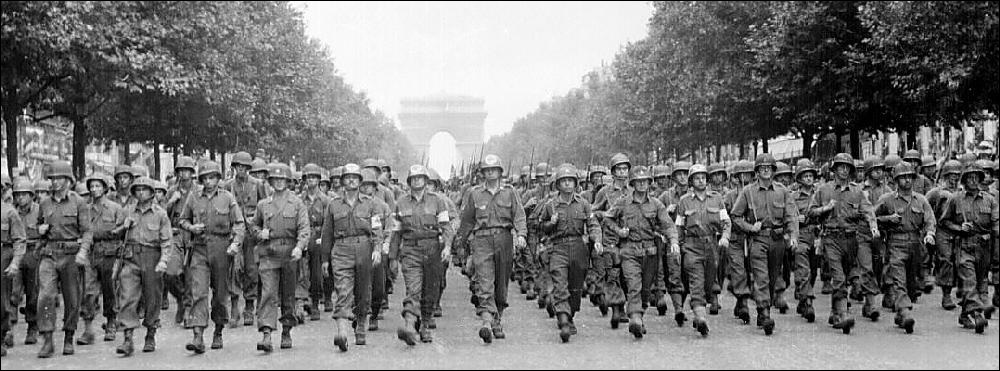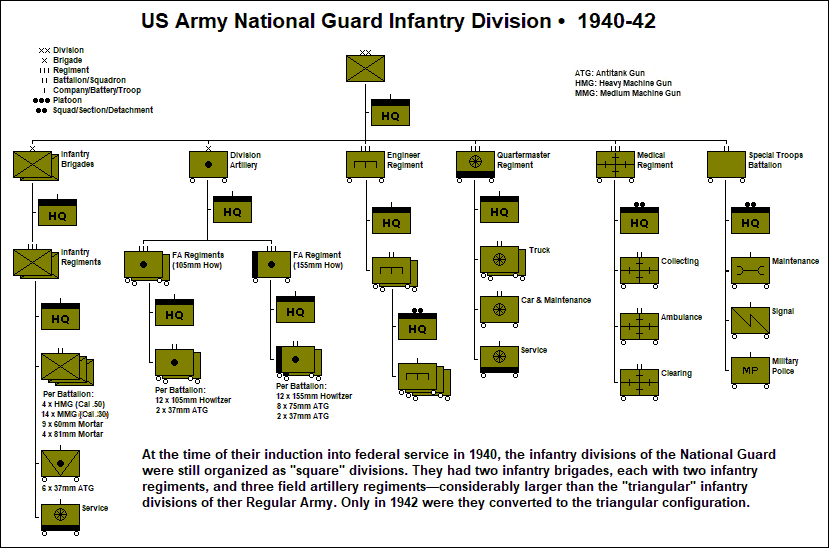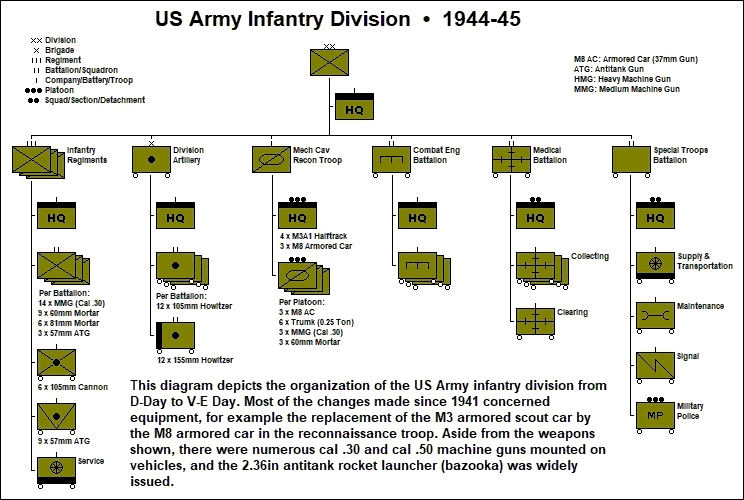|
● ● ●
The history of the
modern US Army infantry division begins with the National Defense
Act of 1916, which provided for an increase in the size of the
Regular Army and the establishment of a permanent divisional
organization. Up to then the largest permanent organization had been
the regiment, and the last time that divisions had existed in large
numbers was during the Civil War.
The organization
adopted for the Army division in 1916, which would also apply to the
National Guard, was “triangular”: three infantry brigades, each with
three infantry regiments, plus artillery and other support units.
(At that time an infantry regiment had the actual strength of a
battalion.) But not much was done to implement this scheme and by
the time that the United States entered World War I in the spring of
1917 it was considered obsolete. Instead, the Army adopted a much
larger “square” organizational template: two infantry brigades, each
with two infantry regiments, each regiment with three battalions.
The square division also had a field artillery brigade with three
regiments (six battalions), an engineer regiment, and a machine gun
battalion. With various modifications, this square configuration
remained standard for the Army’s infantry divisions up to 1939.
In combat the square
division had demonstrated considerable staying power—due to its
size—but it lacked mobility and proved difficult to support. After
the war considerable thought was given to the development of a new,
smaller, more mobile infantry division, with motor vehicles
replacing horses. The ultimate result was a new triangular
organization. The infantry brigades and one of the infantry
regiments were eliminated, the division artillery was reduced to
four battalions, and support units were reduced in proportion. The
overall reduction in manpower was from 22,000 to about 12,500.
The new organization
was approved in 1939 and by late 1941 all infantry divisions of the
Regular Army were triangular. The divisions of the National Guard,
however, retained their square configuration. The reason for this
was partly political. Converting the NG divisions from square to
triangular would deprive many officers of their commands—a prospect
most unwelcome in both the states and the National Guard Bureau.
Only a year to eighteen months after their induction into federal
service (1940-41) were they finally converted.
The officer most
influential in the design of the wartime triangular infantry
division was Lieutenant General Leslie J. McNair, who was Chief of Staff,
General Headquarters (GHQ) US Army from 1940 to 1942 and then
Commanding General, Army Ground Forces (AGF) when that organization
replaced GHQ. He served in the latter capacity until he was killed
in France on 25 July 1944. McNair had been involved in issues of
Army reorganization since the mid-1930s, when he championed the
concept of a lighter, more nimble infantry division. As commander of
AGF, he held primary responsibility for the organization,
mobilization and training of all Army ground combat forces: an
undertaking of vast complexity, embracing a myriad of factors.
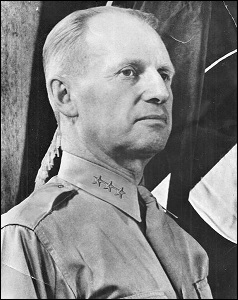
Lieutenant General Leslie J. McNair
as Commander, Army Ground Forces in 1942. (US Army Signal Corps)
One great challenge
that McNair faced was the integration of new weapons into the
infantry division. This affected the organization of the infantry at
every level, from the rifle squad to the regiment. In 1935 the
primary infantry weapons were the bolt-action Springfield rifle; the
Browning Automatic Rifle (BAR); the tripod-mounted, water-cooled
30-caliber Browning machine gun; and the 81mm Stokes mortar of World
War I vintage. In 1938-40, however, new weapons began to be
introduced: the M1 self-loading rifle, a greatly improved BAR, the
Thompson submachine gun, a lighter air-cooled version of the
Browning machine gun, the .50-caliber heavy machine gun, the light
60mm mortar, the 37mm antitank gun. All these new weapons greatly
increased the infantry division’s firepower, despite the reduction
in manpower.
The triangular
infantry division underwent various alterations between 1941 and
1944, but none of these changes affected its basic organization. The
divisional antitank battalions that existed in two or three
divisions in 1941 were removed and allocated to the new Tank
Destroyer Force when it was established late in that year. In
mid-1942 the quartermaster battalion (supply, transport and
maintenance) was dissolved and replaced by separate quartermaster
and maintenance companies. The infantry regiments acquired a cannon
company with six light 105mm howitzers. New and improved weapons
were introduced, such as the M8 armored car (37mm gun) in place of
the machine gun-armed M3 armored scout car, and the 2.36-inch
antitank rocket launcher (bazooka). The ultimate configuration of
the triangular infantry division (1944-45) is shown in the
accompanying diagram.

Distinguishing Flag of the 1st Infantry Division:
"The Big Red One"
Though many of its
sub-units such as the division artillery and the
cavalry
reconnaissance troop were fully motorized, the infantry division as
a whole was not. Though American industry was more than capable of
providing the necessary motor vehicles, Army planners judged that
full motorization of infantry divisions would place excessive demand
on the shipping needed to deploy them to Europe and the Pacific.
(The same considerations led to a reduction in planned armored
divisions from the fifty or sixty envisioned in 1941-42 to the
sixteen ultimately activated.) Instead, quartermaster truck
companies would be attached to infantry divisions as necessary. One
such company, with its 48 x 2.5-ton trucks and 1-ton trailers, was
capable of fully motorizing an infantry regiment.
Nor did the infantry
division include anything in the way of armored fire support
vehicles. In the 1920s the Army distinguished between infantry tanks
(providing such support) and “combat cars” (light tanks in the
cavalry branch) but the evolution of mobile/mechanized combined arms
doctrine did away with this distinction. In 1940 the Infantry branch
lost all control over tank development. While it was recognized that
tank support was vital to the infantry, this would be provided by
independent tank (later armored) groups of two or three tank
battalions. Such groups proved excessively large, however, and
during World War II it became common practice, particularly in the
European theater, to attach a separate medium tank battalion to each
infantry division on a more or less permanent basis. Typically, the
battalion’s three medium tank companies were parceled out to the
division’s infantry regiments. The light tank company could be
attached to the division’s mechanized reconnaissance troop or, with
other battalion elements, held under control of the division HQ as a
mobile reserve.
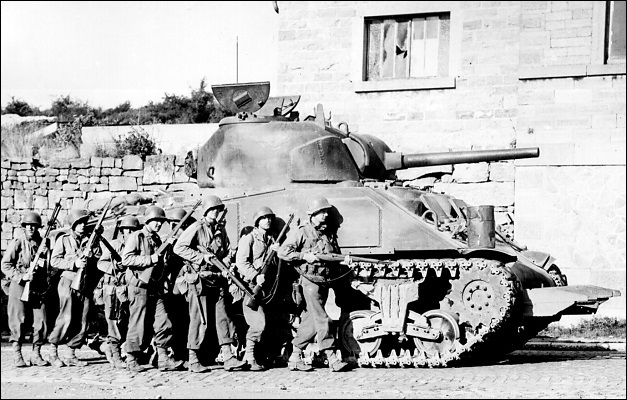
Infantry rifle squad and M4 Sherman
medium tank. (US Army Center of Military History)
The attached tank
battalion was sometimes augmented or replaced by a self-propelled
(SP)
tank destroyer battalion. The SP tank destroyer resembled a medium
tank but it was faster, had lighter armor and an open-topped turret,
and mounted a more powerful main gun. Prewar doctrine had envisioned
TD battalions operating in groups of three or four against enemy
armored forces. But large-scale armored clashes on the Russian Front
model were rare in the European and Pacific theaters and the TD
battalions were mostly attached to armored and infantry divisions.
In the infantry
division both tanks and SP tank destroyers were employed as assault
guns. Individual tanks operating with infantry platoons proved
extremely useful in the 1944-45 Siegfried Line battles, knocking out
enemy bunkers and providing direct fire support for advancing
infantry. The more lightly armored tank destroyers were not quite so
successful in this role, though their high-velocity main guns were
highly effective bunker busters.
No doubt the most
prominent strong point of the triangular infantry division was the
division artillery. This consisted of four battalions: three with a
total of 36 x 105mm howitzers and one with 12 x 155mm howitzers. Not
only were the weapons themselves of excellent design and
performance, but their tactical employment was devastating
effective. Advanced communications and fire direction techniques
made it possible to engage targets rapidly and to mass the fires of
the entire division artillery on a single target. (The organization
and employment of US Army field artillery in World War II will be
covered more fully in a forthcoming article.)
But there were
challenges as well. The most pressing, which became acute in the
European theater during 1944-45, was a shortage of infantry
replacements. In early December 1944, for example, Patton’s Third
Army was 11,000 infantrymen short: roughly the rifle strength of two
infantry divisions. There were two reasons for this: combat
casualties in the infantry and the difficulty of replacing them.
Once a division
entered combat, the main burden of the fight inevitably fell on the
infantry and after a few weeks it was common for a rifle platoon or
company to have suffered nearly 100% casualties—meaning that almost
all of its original personnel had been killed, wounded, evacuated
sick or reported missing. Particularly serious was the loss of
trained small-unit leaders—junior officers and NCOs. These losses,
bad enough in themselves, proved especially hard to replace.
Competing demands for manpower, among the armed forces and among the
branches of the Army itself, meant that there were never quite
enough men allotted to the infantry. And late in the war, the
manpower that was allotted of indifferent quality: 18-year-olds with
less than six months’ training, older classes of draftees, often
with poor educational qualifications. Thus infantry battalions found
themselves manning the line with critical gaps in their ranks, and
little time to absorb the often sketchily trained replacements that
they received.
The Army had been
grappling with this manpower problem since 1942; it was a major
factor in General Marshall’s 90-division gamble. In late 1944,
emergency measures were adopted. Many antiaircraft artillery units,
surplus to requirements after the effective demise of the Luftwaffe,
were disbanded and their personnel distributed as infantry
replacements. Rear-echelon units were similarly assessed and either
disbanded or reduced in strength. But these measure, while helpful,
could not solve the manpower problem, which was by then systemic.
Fortunately, however, Germany was by then on the brink of defeat,
with many of its own divisions reduced to pitiful remnants.
Immediately after
the termination of hostilities in Europe, the General Board,
European Theater of Operations, United States Army, was set up to
conduct a wide-ranging review of the organization, equipment, and
tactical employment of the infantry division in light of combat
experience. The Board's general conclusion was that the wartime
triangular infantry division's major subordinate elements were
insufficient to carry out independent combat operations.
Particularly remarked upon was the lack of an organically assigned
tank battalion. Other recommendations included the addition of an
antiaircraft artillery battalion, a strengthening of the division
artillery, the expansion of the mechanized cavalry reconnaissance
troop into a full squadron, and the augmentation of the division's
service and support elements. In the postwar period most of these
proposals were adopted, though the basic triangular configuration of
the infantry division was retained until it was replaced by the
Pantomic organizational scheme in the late 1950s.
● ● ●
|
